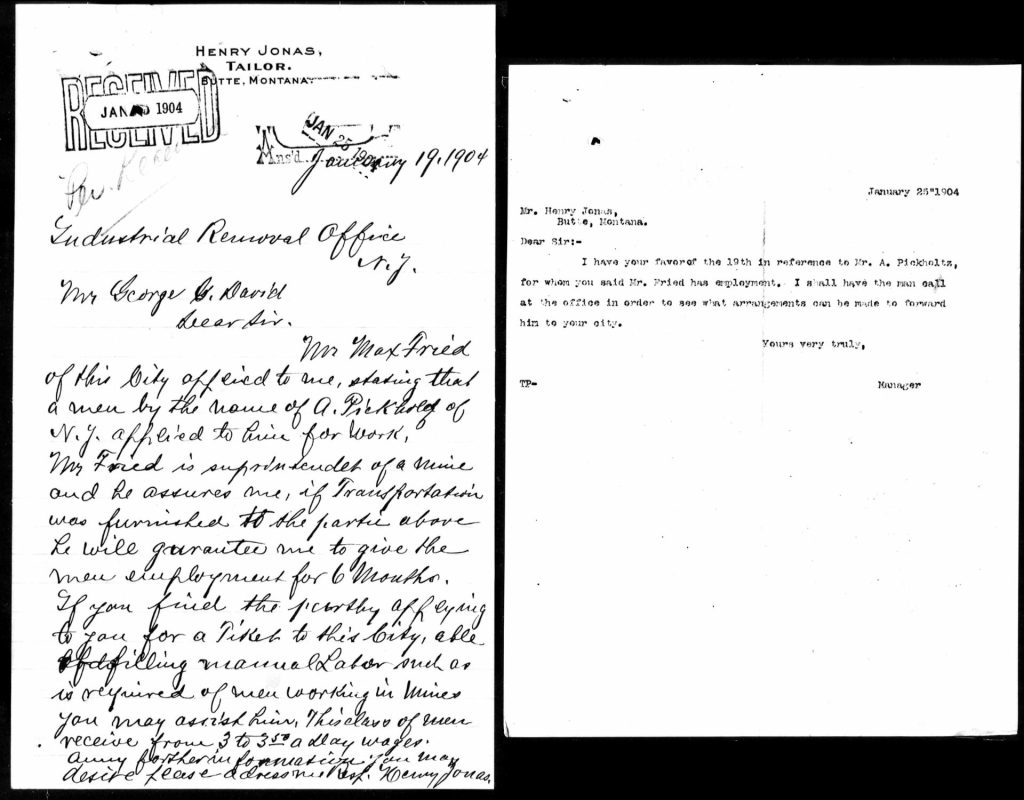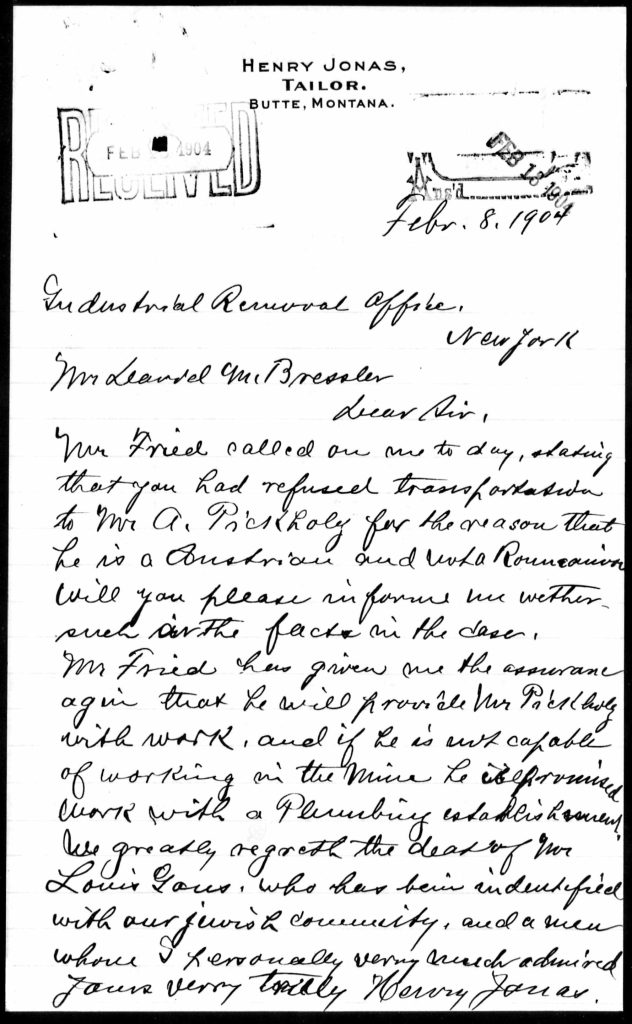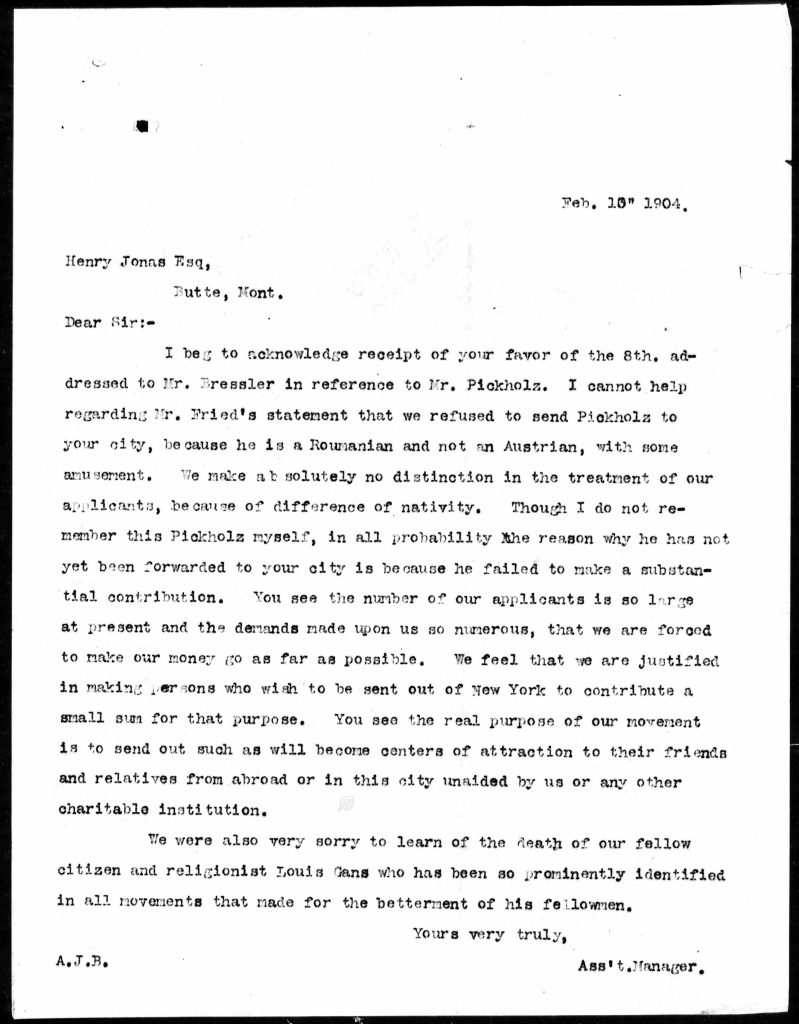June 21, 2024
By Cassandra Euphrat Weston, 2023-24 Lapidus Graduate Fellow
Jews in the Mines: The Industrial Removal Office Contends with Butte, Montana
In January 1904, Henry Jonas of Butte, Montana, wrote to the Industrial Removal Office (IRO) in New York, asking for their help sending a man named A. Pickholz from New York in order to work in Butte’s booming copper mines, at the behest of “Mr. Max Fried of this city.” 1 The IRO existed to coordinate just such Jewish labor migrations out of densely populated Jewish cities like New York and into places like Butte, with the aid of local Jews like Fried to employ them and Jonas to coordinate and vouch for those employment offers. 2 The New York office quickly promised their assistance. [see letters below]

Two weeks later, Pickholz had not materialized in Butte, so Fried prodded Jonas, and Jonas in turn prodded the IRO. He explained: “Mr. Fried called on me today, stating that you had refused treatment to Mr. A. Pickholz for the reason that he is an Austrian and not a Roumanian. Will you please inform me w[h]ether such is the facts in the case.” [see below]

The disdain of the IRO’s New York leadership for the quarrelsome yokels of Butte was evident in their stiff reply. Not even bothering to paraphrase Fried’s accusation correctly or to sign his own full name, the IRO’s assistant manager sniffed: “I cannot help regarding Mr. Fried’s statement that we refused to send Pickholz to your city, because he is a Roumanian and not an Austrian, with some amusement. We make absolutely no distinction in the treatment of our applicants, because of difference of nativity.” [see below]

This prickly exchange offers a surprising glimpse into Jewish economic life in Butte, a fast-booming mining city whose Jewish population numbered a few hundred in 1904. 3 Jonas himself would report to the IRO eight years later that it was “[v]ery hard to find employment for our people [in Butte] as mining industrie [sic] predominates. Our people [i.e. Jews] are limited only to such trades as tailors” — Jonas’ own occupation — “cobblers, painters, watchmakers, clerks and peddlers.” 4 Both academic studies and contemporary community histories of Western Jewish life in Butte and beyond have similarly emphasized Jews’ commercial employment rather than their participation in extractive industries like mining. 5 But Max Fried’s offer of a mining job to a fellow Jew provides a counter-example, demonstrating that Jewish men were among both supervisors and wage laborers in Butte’s famously dangerous and exploitative copper mines. The IRO’s response, meanwhile, illustrates their willingness to facilitate Jews’ labor as miners.
In fact, Max Fried was not merely the “superintendent of a mine,” as Jonas described him. My dissertation research has revealed that he was a central figure in Butte’s vicious copper politics as a close lieutenant of Augustus Heinze, one of the powerful “copper kings” battling for financial and political monopoly. 6 Nor was Fried simply any Butte Jew: he was the co-founder and longtime president of Butte’s sole Orthodox synagogue.7
As his challenge to the IRO suggests, Max Fried was not one to shy away from a fight. My dissertation traces how and why this pugnacious political power broker, synagogue president, landlord, and soon-to-be mine investor soon stood at the center of an explosive controversy over Jewish involvement in Butte’s infamous sex industry, starting around 1909. Five years earlier, however, Max Fried successfully irritated the IRO’s New York leadership all the way from Butte, Montana, in the process nuancing our understanding of early twentieth century Jewish labor and politics in a Western mining city.
- On mining in Butte, see Mary Murphy, Mining Cultures: Men, Women, and Leisure in Butte, 1914-41 (Urbana, Ill.: University of Illinois Press, 1997).
- Jack Glazier, Dispersing the Ghetto: The Relocation of Jewish Immigrants across America (Ithaca, N.Y.: Cornell University Press, 1998).
- Jonas himself would estimate 800 Jews in Butte in 1912, after a period of explosive growth for Butte’s overall population: Henry Jonas survey response on Butte, April 3, 1912, Records of the IRO, Box 83, Folder 30. On Butte’s population growth, see Murphy, Mining Cultures.
- Henry Jonas survey response on Butte, April 1912; Goodman Mottelson, “History of the Jews of Butte,” Reform Advocate, 1914?, VF1096, Butte Silver-Bow Public Archives (BSBPA).
- On Butte, see Pamela Wilson Tollefson, “Myron Brinig’s Butte: Jews in the Wide Open Town” (Masters of Arts thesis, University of Montana, 1994); Julie L. Coleman, Golden Opportunities: A Biographical History of Montana’s Jewish Communities (J.L. Coleman and SkyHouse Publishers, 1994) as well as public history materials.
- On Heinze and the “copper kings,” see Jerry W. Calvert, The Gibraltar: Socialism and Labor in Butte, Montana, 1895-1920, (Helena: Montana Historical Society, 1988). My dissertation pieces together Fried’s political role from a variety of sources.
- Tollefson, 88; Butte City Directory for 1906 (Helena, MT: R.L. Polk & Co, 1906), 73.



I received this from a fellow genealogist, as I am working on the entire Pickholz family. During the 1800s we lived in Austrian Galicia.
The identification of your Pickholz using no more than a first initial makes it difficult, but I have a theory. There was a Szama Pickholz from the town of Budzanow, not far from Rumania, whose wife was a Fried. That may explain Max Fried’s interest.
Szama’s wife had a brother Moshe who could be this Max. Do you know offhand if Max is buried in Butte and is there a photo of his grave?
My theory is that “A. Pickholz” is Szama’s son Uszer, often spelled Asher who was born in 1885. He lived much of his life in New Jersey where he went by “Harry.” He never married.
I would be pleased to hear anything you might have to say further about either of the gentlemen in question.
Thank you.